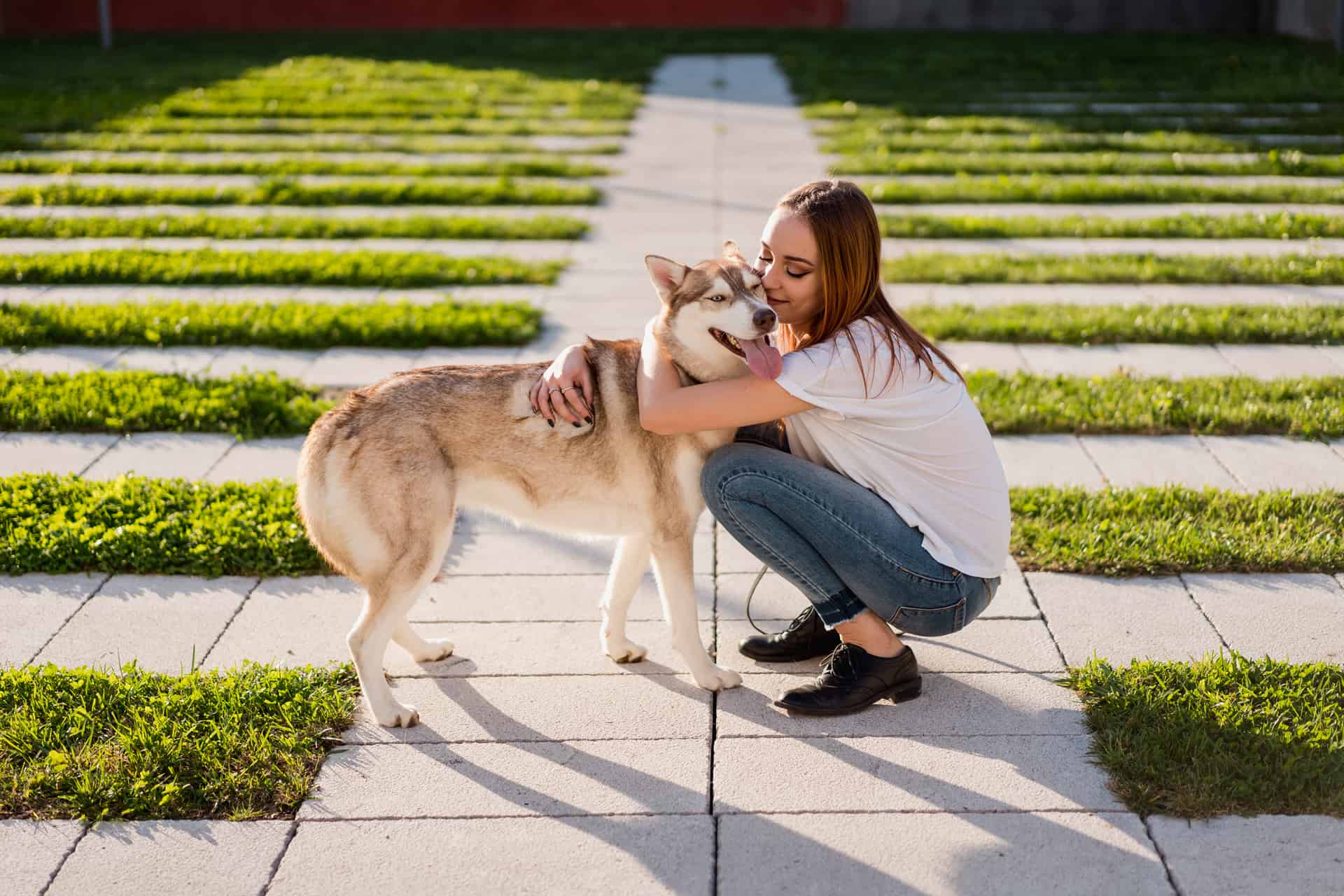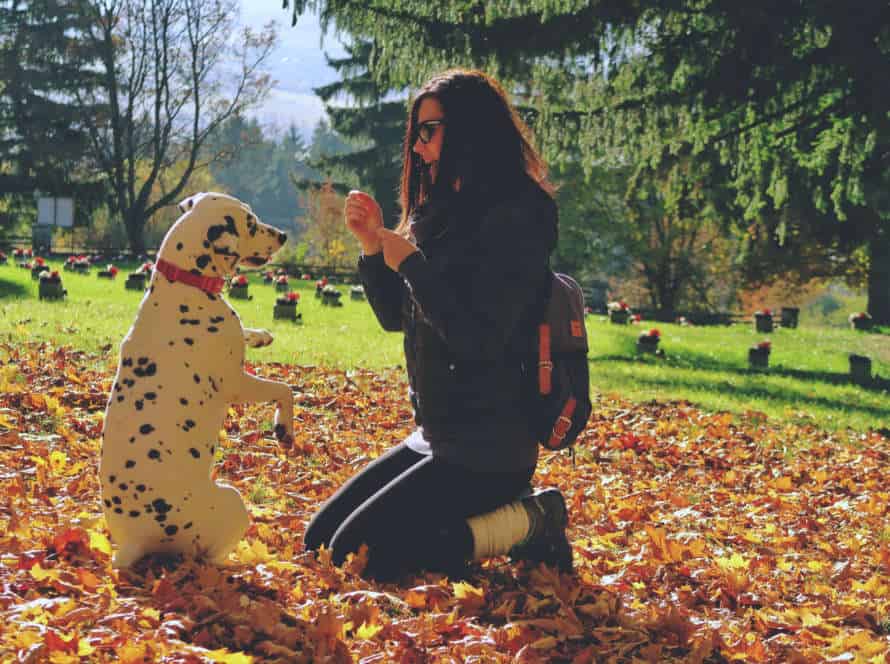Building a Strong Bond with Your Dog to Minimize Barking
Constructing a strong connection with your pup is vital to minimizing excessive barking. It helps to construct trust and create communication and understanding between you and your pooch.
Here are some ideas to create a strong bond with your pup:
- Practice positive reinforcement. Use treats and compliments to reward good behaviour, like sitting on command or responding to a basic obedience cue.
- Set up a routine. Dogs love predictability. So, plan a consistent daily routine for feeding, playing, and exercising.
- Spend quality time together. Do things that you both enjoy, like taking walks, playing fetch, or cuddling on the couch.
- Understand your pup’s body language. Recognize your pup’s non-verbal cues and body language. This will help you communicate better and guess their needs.
- Be patient and consistent. Developing a strong bond takes time and effort. So, be patient and consistent when interacting with your pup.
Understanding Your Dog’s Needs
Strengthening the bond with your pup can improve their behaviour and prevent them from barking too much. Knowing your dog’s requirements and attending to them is important. Comprehending your dog’s physical and emotional needs will help you realise if they are feeling anxious or troubled, which may be why they are barking a lot. Let us take a look at how to meet your dog’s requirements and build a better bond.
Proper Diet and Exercise for Your Dog
Proper diet & exercise are vital for your pet’s health & happiness. To minimize barking, understand your pup’s needs & build a strong bond.
Diet: Feed high-quality food appropriate for age & activity level. Provide fresh water at all times.
Exercise: Regular exercise for physical & mental well-being. Walks, fetch & dog parks. Releases pent-up energy & prevents boredom.
Understand pup needs: Observe behavior & body language. Enjoys, anxious & how to make them comfy.
Bond: Spend time, teach tricks & give rewards. Strengthens bond & trust. Minimizes barking.
Pro tip: Consult vet on diet & exercise plan best suited for breed, age & health.
Creating a Comfortable Living Environment for Your Dog
Creating a comfy living space for your pup is a must to keep them content and healthy. Having an understanding of your pup’s needs and building a strong connection is essential to reduce excessive barking.
Pups are sociable animals that need physical, mental, and emotional stimulation. Here are some ideas to craft a pleasant living environment for them:
- Provide a comfy sleep spot with a warm bed or blanket that fits their size.
- Ensure your pup access to fresh water, nutritious food, and regular exercise.
- Give your pup lots of playtime and training to meet their mental and emotional needs.
- Make a safe and secure space without any harm or danger that could hurt them.
- Bonding with your pup can cut down on barking caused by fear or loneliness. Spend quality time with them by taking them out for a walk, cuddling, or playing games.
Pro tip– Don’t forget to groom your pup often as part of their care routine to remove excess hair and dirt and avoid skin infections.
Grooming and Health Care for Your Dog
To be a responsible pet owner, regular grooming and health care for your pup is a must! Not only does it keep your furry pal in tip-top shape, but it also strengthens the connection between you and your pup. This can lead to less excessive barking. Here are some handy tips:
- Grooming regularly – that includes brushing, bathing, nail trimming, and ear cleaning.
- Feeding them a balanced diet that meets their nutritional needs.
- Making sure they exercise to maintain good physical and mental health.
- Taking them for routine checkups and vaccinations from a vet to prevent illnesses.
- Observing and spending quality time with them, to understand their behaviour and needs.
- Building a loving and supportive relationship with your pup, through positive reinforcement training, playing and cuddling.
Pro Tip: Spend quality time with your pup often to create a strong bond and reduce barking due to separation anxiety.
Training Your Dog with Positive Reinforcement
Train your Dog with positive reinforcement! This is an easy and successful way to create a strong bond with your pup, and reduce barking.
Positive reinforcement is about rewarding your doggo for the right actions and ignoring the bad ones. To teach your pup, focus on the behaviour you want them to have. Here’s how to use positive reinforcement to train your Dog:
Building a Relationship with Your Dog
Having a good connection with your pup is key to reducing their barking. Positive reinforcement training is an awesome way to create a close bond, teach discipline, and reduce their barking. Here’s how:
- Start with basic commands like ‘sit’, ‘stay’, ‘come’, and ‘down’.
- Whenever they obey you, reward them with their favorite treat, a head rub, or kind words.
- Be consistent with the training. Do quick practice sessions each day.
- When they bark too much, give them a toy or treat to distract them.
- Avoid punishments like scolding or shock collars since these can hurt them and ruin your relationship.
Remember: forming a strong relationship takes patience, time, and consistency. The result will be a cheerful and obedient pet that barks less and brings more joy into your life.
Rewarding Good Behaviour
Positive reinforcement is a great way to train dogs. It encourages good behavior and builds a strong bond between you and your furry friend. Here are some ideas on how to reward your pup:
- Treats: Bite-sized treats are an effective positive reward. Immediately after good behavior, give them a treat. Over time, reduce the frequency of treats.
- Praise: Dogs adore compliments and attention from their human. After good behavior, use a cheerful tone to let them know they did well.
- Playtime: Playtime is a great way to reward your pup. It strengthens the connection between you and your dog. Throw a ball or play tug-of-war as a reward for good behavior.
Remember: Positive reinforcement works best when you reward behaviors right away. Be patient, consistent, and persistent. You will see a change in your pup’s behavior!
Using Positive Reinforcement to Minimize Barking
Positive reinforcement – an effective way to reduce a dog’s barking and strengthen the bond with them. Rather than punishing bad behavior, reward good behavior. Here are few tips:
- Identify why your pup is barking. For instance, if they’re bored give them more toys and exercise.
- Give treats, praise and playtime when they’re quiet. This will teach them that calmness leads to good things.
- Don’t acknowledge bad behavior like barking or whining – instead reward the good behavior such as sitting and being still.
Keeping up with positive reinforcement will help your dog learn to control their barking and build a strong bond with their owner.
Minimizing Barking with Environmental Adjustments
Reasons for excessive dog barking may be due to a mix of elements. To reduce barking, make environmental changes. This will make your pup feel safe and relaxed, plus make the bond stronger. Here, we’ll discuss the environmental changes to help reduce your pup’s barking.
Identifying Triggers for Your Dog’s Barking
Dogs can bark for different reasons, such as fear, territory, boredom, and attention. To stop excessive barking, the first step is to identify what triggers your dog.
To reduce barking, you can:
- Block visual triggers – Blinds, curtains, or fencing can stop your dog from barking at people, animals, or movement outside.
- Reduce noise triggers – Play white noise, music, or leave the TV on to avoid loud, sudden noises like fireworks, storms, and construction.
- Exercise and mental stimulation – Boredom and restlessness can cause barking. Make sure your dog gets enough exercise and give them puzzle toys to keep them busy.
Creating a strong bond is important too! Spend time with your dog, give them training, positive reinforcement, and pay attention to their needs. Eventually, your pup will feel more secure and bark less.
Eliminating Triggers
Dogs bark for plenty of reasons, such as fear, boredom, and separation anxiety. To reduce barking, we must identify the triggers. These might be visitors, other dogs, or loud noises.
Once identified, we should minimize the triggers. If visitors cause barking, teach your dog to stay in a specific spot when they come. If noise is the problem, use noise-cancellation devices.
Building a strong bond with your pup also helps to decrease barking. Use positive reinforcement and spend time with them.
Lastly, get your dog the exercise and mental stimulation they need. Boredom and too much energy can lead to excessive barking.
Using Environmental Cues to Distract Your Dog
Using environmental cues to distract your pup is a great way to reduce barking and strengthen your bond. Here’s how it works:
- Create a good connection with a particular cue, like the sound of a toy.
- Use this cue to distract your dog from barking when they’re triggered by something in the environment, like a loud noise.
- Redirect their attention to the toy or another positive thing, like a treat or game.
- Practice the cue in low-stress situations. Gradually increase the distractions and triggers your dog faces.
By using positive cues and distractions consistently, you build a strong bond with your pup, reduce barking, and teach them to connect challenging environments with positive experiences.
Seeking Professional Help
Trying to reduce your pup’s barking but stuck? Seeking professional help may be the answer. A pro trainer can figure out the best way to handle the barking. They can explain why your dog is barking and provide tips on strengthening your bond.
How do you find a pro? Let’s see how it can help.
Consulting a Professional Dog Trainer or Behavioural Specialist
Consulting a professional dog trainer or behavioral specialist is wise. It can help you build a strong bond with your pup and minimize their barking.
A pro can identify the source of their barking and recommend techniques. Positive reinforcement-based training is often suggested. This includes giving treats, verbal praise, or a favorite toy when they do something good.
Desensitization and counter-conditioning techniques may also be recommended. This involves gradually exposing them to things that make them bark and rewarding them for remaining quiet.
Professional help is a great idea as dealing with barking can be complex and hard to do alone. A trainer can guide you and provide the best approach for your pup’s needs.
Medication and Other Medical Interventions
Having a strong relationship with your pup is essential for reducing their barking. If this still doesn’t help, medical treatments may be necessary. Here are some options:
- Anti-anxiety medication: Ask your vet if medication could help reduce stress/anxiety.
- Citronella collars: These collars spray citronella-scented liquid when your dog barks.
- Anti-bark devices: Electronic devices that emit high frequency sounds to discourage barking.
However, medication and other medical interventions should only be used as a last resort. Positive reinforcement training is key for building a strong bond with your dog.
Tips for Finding the Right Help for Your Dog
In search of assistance to reduce your pup’s barking? It is important to find the right person or group. Here are some tips:
- Look for a qualified dog trainer or behaviorist experienced with dogs with barking issues.
- Ask your vet or other dog owners for referrals.
- Do research online or contact local dog training organizations or animal shelters.
- Analyze the trainer or behaviorist’s training methods & philosophy. Make sure they match your values & goals for your dog.
- Make sure you feel comfortable with the trainer/behaviorist & they communicate clearly with you.
The right professional can help you strengthen your bond with your dog & lessen excessive barking.
Maintenance and Long-Term Strategies
Creating a solid connection with your pup is key for training him to bark less. Positive reinforcement, clear communication, and reward-based training can help you build a strong bond. This trust can be used with other long-term approaches to reduce your pup’s barking.
Let’s take a look at some long-term plans and maintenance strategies to decrease your pup’s barking.
Monitoring Your Dog’s Progress
For an awesome bond with your pup and hushed up barking, monitoring their progress is crucial. Keep these tips in mind to keep tabs:
- Set achievable goals and expectations for their behaviour.
- Reward good behaviour using positive reinforcement techniques.
- Track changes in barking habits and behaviour using a journal or calendar.
- If necessary, get help from a professional dog trainer or behaviourist.
- Invest time and energy in your pup! Quality time, exercise, attention and mental stimulation will strengthen your bond.
- Remember, consistency is key! Show patience but persist, and don’t be afraid to seek help if you need it. By investing in your pup, you’ll create a blissful home for both of you!
Maintaining a Strong Relationship with Your Dog
Dogs need love and attention to have a strong bond with their owners. Here are some tips to help you keep a strong relationship and reduce barking:
- Regular Exercise: Walks and playtime help your dog burn off energy and stay healthy. Plus, they are a great way to bond with your pup!
- Positive Reinforcement Training: Reward good behavior with treats, praise or toys instead of punishment. This teaches your dog to see you as a source of relief.
- Consistency: Consistent training and routines help your dog understand what you’re saying.
- Regular Vet Visits: Check-ups keep your pup healthy and happy.
- Spending Quality Time Together: Games, hikes and drives are fun ways to spend time with your dog and reduce barking.
Pro tip: Positive communication and showing your love is the key!
Continued Training and Reinforcement to Minimize Barking.
Training and reinforcement are essential to reduce barking in dogs. But long-term strategies and a strong bond are also key! Try these tips:
- Regular exercise – Stress, anxiety, and boredom can cause excessive barking. Give your pup enough exercise to prevent it.
- Positive reinforcement – Praise, playtime, and treats for good behavior. Avoid scolding or punishing.
- Consistency – Make sure you’re consistent with training and communication.
- Socialization – Socialize your pup with other dogs and people to reduce fear and anxiety.
- Training – Use verbal commands, whistles, toys, and treats to improve communication and obedience.
Pro Tip – Be patient and understanding with your pup. If barking persists, seek help from a professional.
Frequently Asked Questions
Q: Why does my dog bark so much?
A: Dogs bark for a variety of reasons, including alerting their owners to danger, expressing boredom or frustration, seeking attention, or communicating with other dogs.
Q: How can I build a stronger bond with my dog?
A: Building a stronger bond with your dog involves spending quality time together, providing positive reinforcement during training sessions, engaging in regular exercise and play, and showing affection and love through physical touch and praise.
Q: What are some effective techniques for minimizing barking?
A: Effective techniques for minimizing barking include distraction, redirection, positive reinforcement training, and providing plenty of exercise and mental stimulation.
Q: How often should I train my dog to minimize barking?
A: Regular training sessions are essential for minimizing barking, but the frequency of training sessions will depend on your dog’s individual needs and temperament. Generally, training sessions should occur at least once a day, but they can be more frequent if necessary.
Q: Is it possible to stop a dog from barking altogether?
A: It is unlikely that you will be able to stop your dog from barking altogether, as barking is a natural and necessary way for dogs to communicate. However, by using positive reinforcement training techniques and providing proper exercise and stimulation, you can minimize excessive barking.
Q: Can I build a strong bond with an older dog?
A: Absolutely! Building a strong bond with an older dog involves patience, consistency, and understanding. By providing plenty of exercise and affection, as well as regular training and socialization, you can build a strong and loving bond with your older dog.







